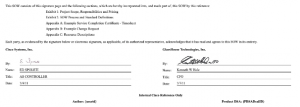When working with staff augmentation, it´s important to establish ground rules from the start. You´ll be working with temporary staff, so they´ll have access to confidential processes, technology, and data. To keep your business interests safe, it’s key to build a staff augmentation agreement that establishes your priorities, what you expect from your augmented staff, and, more importantly, protects your business.
What is Staff Augmentation?
Staff augmentation is a powerful outsourcing strategy that allows businesses to hire temporary staff. Especially in IT, where talent is in high demand and companies often need specific skills, working with IT staff augmentation strategies enables organizations to easily hire for the roles they need.
This hiring model benefits companies as they can:
- Increase their capacity.
- While staff augmentation often focuses on temporary staff, it also works as a bridge to hiring for longer-term needs.
- Hire specialized skills.
- Access to a bigger talent pool as they can focus on remote talent.
Staff augmentation is often referred to as outsourcing. However, they are different. While both focus on helping companies scale their teams, staff augmentation enables companies to have control over projects. You hire external talent, but they still adapt to your processes and maintain your quality standards. On the other hand, outsourcing means giving control of a project to an external source.
What’s a Master Agreement for Staff Augmentation Services?
When you hire employees, you need to write an employment contract that basically describes the role and responsibilities of the employee, your expectations, and also what you will do for them (salary, holidays, etc). Usually, these contracts contain information such as the duration of the job, responsibilities, benefits, protection of trade secrets and client list, and more.
Similarly, a staff augmentation service agreement focuses on establishing the rules and requirements both your augmented staff and you need to follow. For example, if you think its important that your IT expert focuses only on your project, whether because of sensitive information or other reasons, you can establish a clause in your staff augmentation services agreement that prevents them to collaborate with a competitor while they render their services to your business.
Having a master agreement for staff augmentation services protects your business from vulnerabilities as the staff is expected to remain confidential.
Master Agreement for Staff Augmentation: 3 Things Managers Need to Include
A staff augmentation contract format depends on the role, requirements, and business interests. Not a single template works for everyone as it depends on different aspects.
However, as a general guideline, these are some of the relevant things most staff augmentation agreements include:
1) Skeleton of the Master Agreement
During the first part of the staff augmentation agreement, you need to specify the type of contract (in this case, staff augmentation), when it was made, and between who the contract is and the company’s locations. For example,
THIS AGREEMENT FOR STAFF AUGMENTATION SERVICES (“Master Agreement”) made on (add the date) is by and between (add the registered name of your company) and (the name of the staff augmentation company), a staff augmentation agency located in (add the location).
This Statement of Work (SOW) consists of this signature page and the following sections which will make reference to
Article 1: Master Agreement
Article 2: Project Scope, Responsibilities, and Pricing
Article 3: Term and Termination
Article 4: Confidentiality
Here you can add the articles you consider relevant for the position; it can have as many as you think it’s necessary. Below this introductory part, you leave space for the signatures of both companies. Here´s an example by Cisco Systems:
2. Articles You Consider Relevant
In the core part of the master agreement, you need to define the articles you think are important both you and the staff augmentation should agree on. These are usually the ones included in these agreements:
- Project Scope
This article explains everything about the project. You define what will be the:
- The main roles and responsibilities the staff augmentation team should assume
- The locations (where will they be working, if in your organization, remotely, or in another facility)
- The expected timeline (the duration of the services, when will they start, and the estimated end date)
For example
| Service Name | Location | Duration | Estimated Start Date | Estimated End Date |
Additionally, here is where you gather the personal and relevant information between the company and the subcontractor. This is to make communication easier between both entities. The format should look like this:
Staff augmentation company name:
Title: (Role and name of the person)
Telephone number:
Email address:
Additional contact information:
- Responsibilities
This article of the Master Agreement should cover all the responsibilities the staff augmentation team will have. You need to be detailed and clear with your expectations to avoid misunderstandings.
- Compensation and Payment
Is the monthly submitted on a monthly basis? Weekly? How will that work? How much will you pay subcontractors?
All this information needs to be defined, as well as where you will be paying for their services. If via a bank or a money transfer platform.
- Term and Termination
This part establishes when your company has the right to terminate an agreement (for example, if the subcontractor doesn’t fulfill their responsibilities and obligations, or if they don´t deliver specific results, you have the right to terminate the service immediately).
Also, during this part, you need to establish how early you need to let the other party know if you’ll be terminating their services. And how flexible you are in terms of termination, as on the other hand, they might want to be the ones who no longer want or can provide you with personnel.
- Confidentiality
One of the most important parts of a master agreement is confidentiality. Here you need to define what you understand by confidential information (for example, for your company, all information that circulates around the company, regardless of its relevancy, is confidential and can´t be discussed outside the organization)
As explained above, if you don’t want to take risks, you can add a clause stating that the new staff can’t work for competitors or other companies while working with you.
- Intellectual Property
Likewise, if you want to protect the processes and results you produce in your business, you can add an intellectual property agreement where second parties can´t use the inventions, ideas, or discoveries that took place while working for you.
Additional articles can include aspects like insurance, identification, equipment, travel, and additional expenses, among other things. When writing your master agreement, what matters is that you are clear with the aspects that are most important for you. Most companies write extensive agreements in detail that help them avoid misunderstandings.
3. Final Signature
To close and finalize your master agreement, the last part consists of signing it, representing that both parties understand the implications of working together. Following on the Cisco previous example, here´s how their agreement finishes:
Wrapping Up
When working with external entities and using alternative hiring strategies like staff augmentation is fundamental to write master agreements that everything is clear. This will make the process faster and more effective as subcontractors will be clear on their roles, how long they have to fulfill them, and overall your expectations. But even more importantly, you will protect your clients and your business information.
About the Author
 Gabriela Molina is the writer and Editor-in-Chief of the DistantJob blog. As a former freelance journalist, she has covered a wide range of topics throughout her career. She was featured in Datasciencentral, and Simpleprogrammer, to name a few. She is currently specializing in the areas of technology, leadership, and remote work.
Gabriela Molina is the writer and Editor-in-Chief of the DistantJob blog. As a former freelance journalist, she has covered a wide range of topics throughout her career. She was featured in Datasciencentral, and Simpleprogrammer, to name a few. She is currently specializing in the areas of technology, leadership, and remote work.













